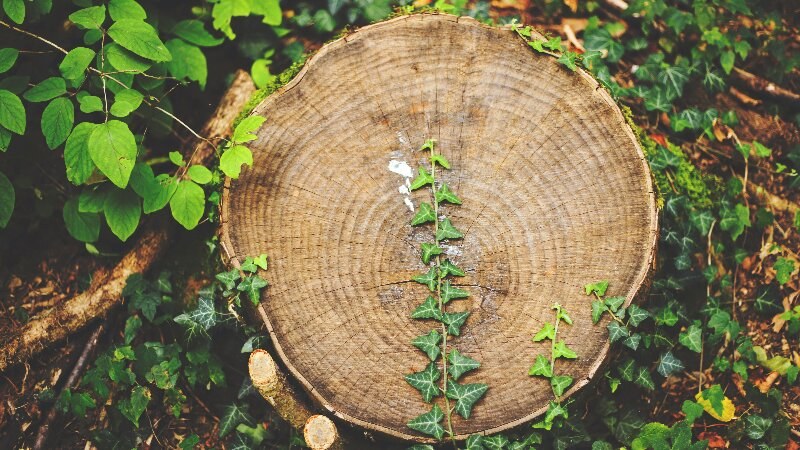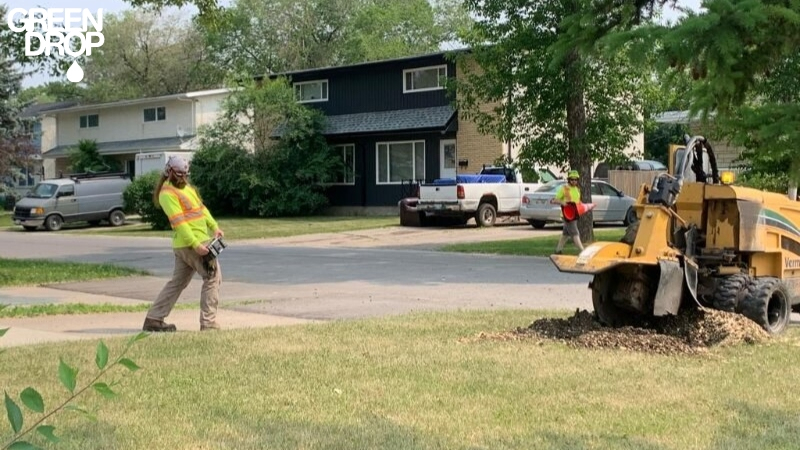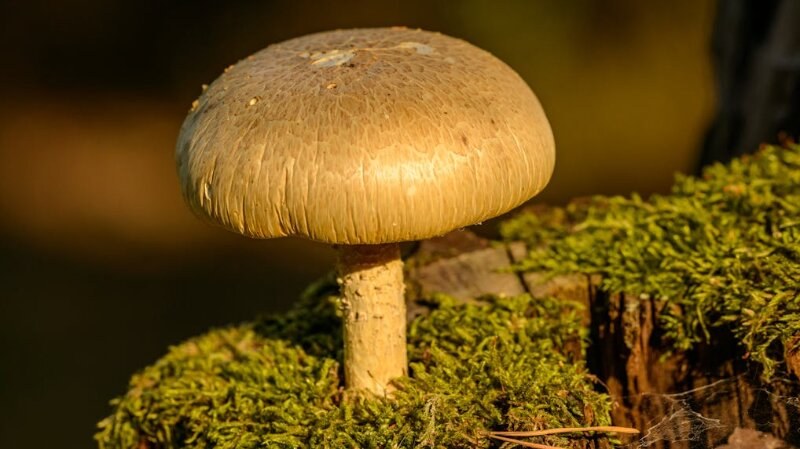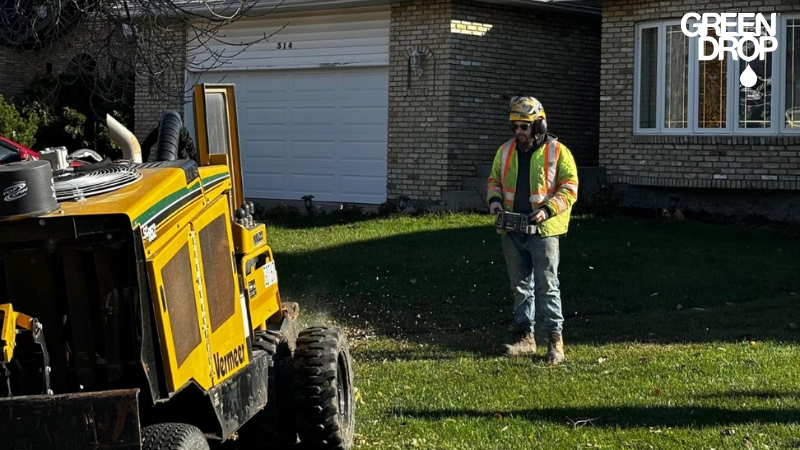Stump Removal vs Stump Grinding— What's Right for Your Calgary Lawn?
Reading time: 6 minutesSo, you’ve got an ugly tree stump in your yard. What are you going to do with it? If you’re like most homeowners, you’re not really sure what the next step is. Our ISA-certified arborists walk you through your options so you can make the right choice for your Calgary tree.

Stump Grinding & Removal 101
Unfortunately, you can’t just leave a stump alone after a tree is cut down. Not only is this an eyesore, but it’s also a tripping hazard and can impact the health of surrounding trees, grass, and soil.
You could decorate your stump, but this creates a different problem. As it deteriorates, the decay attracts wood-boring pests like carpenter ants, termites, and emerald ash borers. This might not seem like a big issue since you want the stump gone anyway, but you can be sure these critters will move on to your garage or house next.
You essentially have two options to deal with the issue: stump grinding or removal.
Stump Grinding—The Benefits & Drawbacks
Stump grinding is the process of removing the visible part of the stump above the ground with machinery that chops the wood into tiny pieces. Stump grinders reach about 6 inches down, cutting off the top part of the root system and leaving a mostly flat surface that can be integrated seamlessly with the rest of your lawn.
The Pros
Stump Grinding Is Very Quick
Stump grinders are powerful and efficient, often completing a job within just hours of starting. Cutting away a stump by hand with an axe or even power tools is backbreaking work, but a grinder won't break a sweat.
It’s Clean
Removing a stump leaves a large hole behind that needs to be filled and can damage your lawn. However, grinding a stump away requires much less cleanup.
It’s Safe
Tree stumps left in the ground can pose safety hazards, especially in high-traffic areas or where children play. Stump grinding eliminates these risks, reducing the likelihood of accidents such as trips, falls, or collisions.
Prevention of Regrowth
When a tree is cut down, its stump can still produce new shoots or suckers, leading to unwanted regrowth. Grinding the stump below ground level, for the most part, prevents this regrowth, saving you the hassle of continually dealing with sprouting saplings.
It Preserves Your Landscape
Since stump grinding only evens out the surface of your landscape and doesn’t dig down into it, you can avoid creating problems associated with a large hole in your front or back yard. It’s also better for the environment than stump removal.
Cons
Creates a Lot of Mulch
Grinding a stump generates a lot of wood chips, which are great for mulch. This is basically just an issue if you don’t have anywhere to put it. We offer mulch removal services, too, so you never have to worry about what to do with your leftover wood.
Noise Complaints
Stump grinding makes a lot of noise; sometimes, neighbours aren't enthusiastic about the sound. To address this, we use equipment mufflers that help cut the volume of grinding noise and can schedule your job at off-peak times.
Stump Removal—The Benefits & Drawbacks

Stump removal is the alternative to grinding and involves completely eradicating the stump and the entire root system underneath the ground. Depending on the size of the tree and its root system, this can be an intense project. Most root systems are as large as the tree’s crown or even bigger, so you need to dig pretty far into the ground to reach everything.
Pros
Eliminates Tree Roots
Unlike stump grinding, which only grinds the stump below ground level, stump removal extracts the entire stump, including the roots. This eliminates any potential for regrowth (already unlikely but not entirely impossible with stumpy grinding) and ensures a clean landscaping or construction slate.
Reduces the Risk of Pests
Decaying wood is a magnet for pests; leaving roots behind could attract them to your yard. It’s less risky than leaving the whole stump, but it's still possible. Complete removal eliminates this scenario.
Cons
More Expensive
Because stump removal is a more involved process, it usually costs more to have done than grinding. That’s also just for the cost of the service itself. With removal, you have the additional expense of filling the hole and restoring your landscaping.
Takes a Lot of Time
Digging a tree stump out of the ground can take a long time, even with the right equipment. Arborists need to locate all of the tree’s roots first and then remove each section to ensure no regrowth occurs, especially with species that reproduce via root graft.
When Is Stump Removal Needed?

As you can see, having your entire tree stump removed is labour-intensive and can be costly. Plus, it leaves behind an unsightly hole that needs to be filled. That said, some stumps still need to be removed. This could be the case if:
- The stump is already starting to attract pests
- You plan on doing construction on top of the ground where your stump is
- You want to plant a new tree in the same spot as your old one
- You have the supplies on hand to fill the space once the root stump is removed
What to Do After
The next steps you take after having a tree stump ground down or removed play a key role in the overall finished project. Here are some important things to do:
- Clean up debris around the job site. Whether you used a tree stump grinding service in Calgary or had your stump removed, check the job site and clean up any leftover wood chips or pieces of tree roots.
- Fill the open hole in the ground. If your stump was ground down, you probably only have about 6 inches or so of depression that will need to be filled. If it was removed entirely, you’ll have much more. Either way, this should be filled with topsoil. If the hole is very deep, you can fill it partially with wood chips or mulch and then put a layer of topsoil over that.
- Now is a great time to have your soil tested and adjust the texture before planting.
- Sow your grass seed. If you’re making the area part of your lawn, sow your cool-season grass seed soon after filling the hole. You can also lay sod down if you want “instant grass.”
- Plant a new tree. If you’re planting a new tree in the exact spot where the stump was, you don’t have to fill the hole as much since the young roots will need to be buried several inches deep. You can plant your tree as soon as your soil is conditioned.

How a Calgary ISA-Certified Arborist Can Help You
Don’t leave your trees to chance, even if it’s just a stump. Our ISA-certified arborists have the equipment and skills for professional stump grinding and removal, leaving a beautiful, flat surface behind for your lawn, garden, or yard features.
Book your appointment today to have an arborist come to your Calgary home for a quote. We also serve the areas of Edmonton, Red Deer, Regina, Saskatoon, Winnipeg, and surrounding cities throughout Western Canada.

